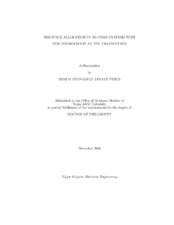| dc.contributor.advisor | Miller, Soctt L. | |
| dc.contributor.advisor | Narayanan, Krishna R | |
| dc.creator | Peiris, Bemini Hennadige Janath | |
| dc.date.accessioned | 2007-04-25T20:15:57Z | |
| dc.date.available | 2007-04-25T20:15:57Z | |
| dc.date.created | 2006-12 | |
| dc.date.issued | 2007-04-25 | |
| dc.identifier.uri | https://hdl.handle.net/1969.1/5004 | |
| dc.description.abstract | In a multiuser DS-CDMA system with frequency selectivity, each user’s spreading
sequence is transmitted through a different channel and the autocorrelation and
the cross correlation properties of the received sequences will not be the same as
that of the transmitted sequences. The best way of designing spreading sequences
for frequency selective channels is to design them at the receiver exploiting the users’
channel characteristics. By doing so, we can show that the designed sequences outperform
single user AWGN performance.
In existing sequence design algorithms for frequency selective channels, the design
is done in the time domain and the connection to frequency domain properties
is not established. We approach the design of spreading sequences based on their
frequency domain characteristics. Based on the frequency domain characteristics of
the spreading sequences with unconstrained amplitudes and phases, we propose a
reduced-rank sequence design algorithm that reduces the computational complexity,
feedback bandwidth and improves the performance of some existing sequence design
algorithms proposed for frequency selective channels.
We propose several different approaches to design the spreading sequences with constrained amplitudes and phases for frequency selective channels. First, we use the
frequency domain characteristics of the unconstrained spreading sequences to find a
set of constrained amplitude sequences for a given set of channels. This is done either
by carefully assigning an already existing set of sequences for a given set of users or by
mapping unconstrained sequences onto a unit circle. Secondly, we use an information
theoretic approach to design the spreading sequences by matching the spectrum of
each user’s sequence to the water-filling spectrum of the user’s channel.
Finally, the design of inner shaping codes for single-head and multi-head magnetic
recoding channels is discussed. The shaping sequences are designed considering them
as short spreading codes matched to the recoding channels. The outer channel code
is matched to the inner shaping code using the extrinsic information transfer chart
analysis.
In this dissertation we introduce a new frequency domain approach to design
spreading sequences for frequency selective channels. We also extend this proposed
technique to design inner shaping codes for partial response channels. | en |
| dc.format.extent | 548402 bytes | en |
| dc.format.medium | electronic | en |
| dc.format.mimetype | application/pdf | |
| dc.language.iso | en_US | |
| dc.publisher | Texas A&M University | |
| dc.subject | DS-CDMA | en |
| dc.subject | Spreading | en |
| dc.subject | Frequency Selective | en |
| dc.subject | Spectrum Matching | en |
| dc.title | Resource allocation in DS-CDMA systems with side information at the transmitter | en |
| dc.type | Book | en |
| dc.type | Thesis | en |
| thesis.degree.department | Electrical and Computer Engineering | en |
| thesis.degree.discipline | Electrical Engineering | en |
| thesis.degree.grantor | Texas A&M University | en |
| thesis.degree.name | Doctor of Philosophy | en |
| thesis.degree.level | Doctoral | en |
| dc.contributor.committeeMember | Allen, G. Donald | |
| dc.contributor.committeeMember | Georghiades, Costas N. | |
| dc.contributor.committeeMember | Reddy, Narasimha R. | |
| dc.type.genre | Electronic Dissertation | en |
| dc.type.material | text | en |
| dc.format.digitalOrigin | born digital | en |


